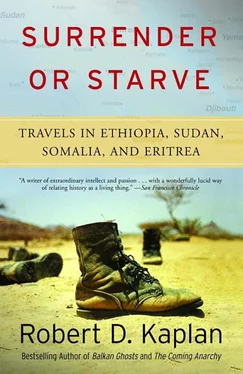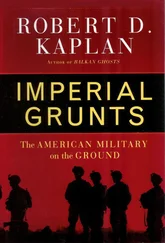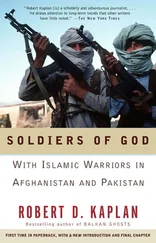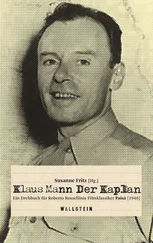In 1979, on the heels of their successful Ethiopia gambit, the Soviets got interested in North Yemen, which with a population three times larger than South Yemen’s was, like Ethiopia, the prize of the region. The Saudi Arabians offered the North Yemeni leader Colonel Ali Abdullah Saleh $300 million in aid to keep the Soviets out. Moscow responded with a $1 billion arms program spread over the next five years for the thirty-five-thousand-troop North Yemeni military, which consequently was Soviet trained and Russian speaking and equipped with MIG bombers, T-62 tanks, and SAM antiaircraft missiles.
Still, the Soviet position in North Yemen was insecure. True to their own past, the North Yemenis liked to keep all foreigners at bay and have accepted aid from several Western nations, including the United States, as a brake against further Soviet influence. Marxism is definitely not to the North Yemenis’ liking. Not even their own government had control over the local economy, which was based on smuggling and functions as a kind of unofficial, duty-free market: Rice Crispies and Frosted Flakes are available in corner groceries in the capital of Sana’a.
The discovery of oil in North Yemen in July 1984 by the Dallas-based Hunt Oil Company made the Soviets especially nervous, according to Western diplomats in Sana’a. At the time, the two Yemens were involved in unification talks (one of many attempts throughout the years to end the official division of 1934, when the British, in Aden, were forced to recognize the imam’s sovereignty north of a line that is the present-day boundary between North and South Yemen). Moscow was worried that unification would allow the more populous, free-market country to the north, now buttressed by U.S.-exploited oil, to dominate and eventually submerge its smaller and poorer Marxist neighbor to the south.
Soon after oil was discovered in North Yemen, Moscow sent Abdul Fatah Ismail, the former president of South Yemen, home to Aden to rejoin the Politburo after a five-year exile in the Soviet Union. Even by South Yemen’s insane standards, Ismail was a hard-liner, who in the late 1970s had signed a friendship treaty with the Soviets and made his strategically located country of two million an observer member of Comecon. The Kremlin’s intention was for Ismail to sabotage the policy of rapprochement with North Yemen instituted by the current South Yemeni president, Ali Nasser Mohammed.
However, the Soviets underestimated the deep personal antagonisms, further aggravated by tribal differences, between Ismail and Nasser Mohammed. On January 13, 1986, guns were drawn at a Politburo meeting and Ismail was badly wounded. Although the details never will be known, Ismail may have walked into an ambush set by Nasser Mohammed similar to the ambush Mengistu set for his rivals nine years earlier. Fighting erupted throughout Aden, and the Soviets at first supported Nasser Mohammed, with Moscow Radio describing Ismail on three successive days as a “coupist” and “agent of reaction.” But as the revolt against Nasser Mohammed gathered steam, the Soviets quickly switched sides. According to diplomats’ accounts and published reports, Soviet ships delivered ammunition to Ismail’s Laheej tribespeople. Soviet advisers helped direct tank and artillery fire, and Soviet planes bombed the airport in support of the rebels. When the dust cleared two weeks later, ten thousand people were dead and billions of dollars worth of property was damaged. As in Ethiopia the previous decade, it was another example of the Soviets brutality working their will while the outside world looked the other way.
Ismail himself was one of the casualties. Aden Radio gave several conflicting accounts of how he died. There is a strong suspicion that he may have met his end in Moscow, where some diplomats believe he was taken after being wounded in the January 13 shootout. Prior to the official announcement of his death, Soviet diplomats in Sana’a were saying that Ismail was “finished politically” because Moscow had “no interest” in backing a man “known throughout the Arab world as an extremist.” Conceivably, Ismail was left to die, or even eliminated, once it was clear that the new, hard-line regime in South Yemen that he helped establish was firmly in place. It would not be the first time that Moscow had done in a socialist hero once he had outlived his usefulness.
At the very least, Ismail’s death was convenient for the Soviets. In place of a shrewd, powerful leader such as Ismail, the Aden bloodbath had thrown up a group of gray men who were even more subservient to the Kremlin than the last bunch had been. The new South Yemeni president was Haydar abu Bakr Attas, a man of no political talent who commanded little popular support. His first act after assuming the post was to fly straight to Moscow for consultations. The Soviets had learned well from their experience in Somalia in the late 1970s: in taking over Ethiopia they had been forced to give up Somalia because Somali leader Siad Barre was still independent enough to force the Soviets to make a choice. But the new South Yemeni leader would be no Siad Barre. In their drive to dominate the Red Sea–oil choke point, the Soviets would have fewer hard choices to make.
It was a messy operation and didn’t go according to plan. Not even the Soviets were anticipating a tribal war that would cost ten thousand lives. But in the end, they still got what they wanted—a regime in South Yemen with absolutely no mind of its own, thus leaving the Soviets free to do whatever was necessary to further improve their position in North Yemen.
The 10,000-barrel-a-day refinery that opened in mid 1986 in North Yemen, along with a planned 250-mile pipeline to the Red Sea, could be vulnerable targets for Soviet-inspired sabotage. The oil fields are in the desert near the frontier with South Yemen where the border is not always secure or even delineated. It also should be remembered that the massive Soviet military aid program means that the USSR had influence in North Yemen where it counts. Even Western diplomats in Sana’a admitted that Moscow’s intelligence sources no doubt were better than theirs.
Mengistu’s greatest fear was enacted in South Yemen in January 1986: the Soviets were prepared to shed blood, and lots of it, merely to replace one subservient ruler with an even more subservient one. Mengistu, a brawler by nature, at first fought back. In what may have been his only blatantly hostile act ever toward Moscow, for several days he supplied arms to Nasser Mohammed’s supporters while the Soviets were arming the Ismail faction. But a visit of several high-ranking Soviet officials to Addis Ababa quickly brought Mengistu into line. Given the facts of life as brutally demonstrated in Aden then, one of the last things the Ethiopian leader needed to do was to pay political tribute to the West for its famine assistance. His life depended upon what the USSR thought of him, not what the United States thought.
FIVE
Aid: Rolling the Rock of Sisyphus
None the less, he knew that the tale he had to tell could not be one of final victory. It could be only the record of what had had to be done, and what assuredly would have to be done again in the never ending fight against terror and its relentless onslaughts… by all who, while unable to be saints but refusing to bow down to pestilences, strive their utmost to be healers.
—Albert Camus,
The Plague
Khawaja is a Sudanese Arabic word that means “a white foreigner.” When a British aid worker in Khartoum told a middle-class Sudanese woman that millions of Sudanese were close to death due to a famine in the far west of the country, she exclaimed, “My God, are those khawaja s going to have a crisis on their hands!”
Читать дальше












